The Pizzly bear, also known as a grolar bear or nanulak, is a rare hybrid resulting from the mating of polar bears and grizzly bears. While it may seem surprising, these two species can indeed interbreed, producing fertile offspring. This phenomenon has become increasingly relevant as climate change alters habitats, leading to more encounters between the two species. Pizzly bears combine physical characteristics from both parents, often showcasing the white fur of polar bears alongside the darker fur patterns of grizzlies, making them a fascinating subject of study in the animal kingdom.
As the prevalence of pizzly bears increases, they highlight the adaptability and resilience of wildlife in changing environments. Their existence raises important questions about biodiversity and conservation efforts, particularly in the context of habitat loss and climate change. Here are 10 amazing facts about pizzly bears that reveal more about these unique hybrids and their role in our understanding of bear biology and ecology.
Pizzly Bear Facts
1. Pizzly Bears are Smaller than Polar Bears but Larger than Grizzlies
Pizzly bears, the hybrids between polar bears and grizzly bears, exhibit physical characteristics that are generally intermediate between their parent species. On average, these fascinating animals are smaller than polar bears, which can weigh up to 1,500 pounds (680 kg) and stand over 10 feet (3 meters) tall on their hind legs, but they are larger than grizzly bears, whose weights typically range from 400 to 1,200 pounds (180 to 540 kg).
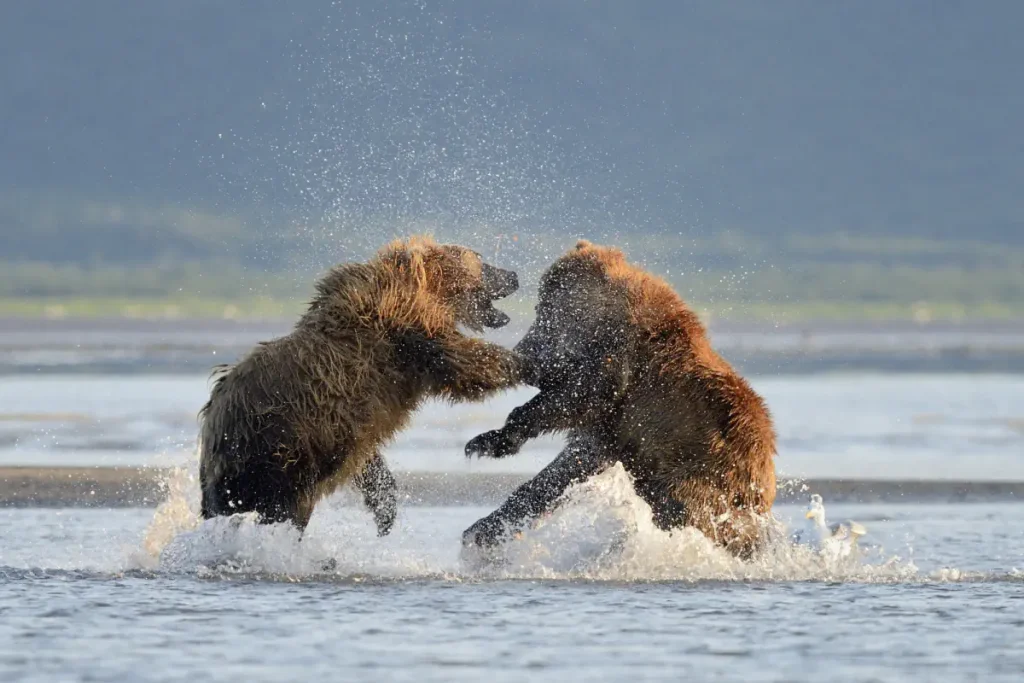
Related: 20 Amazing Grizzly Bear Facts
2. They Share the Body Characteristics of Their Parent Species
Pizzly bears exhibit a fascinating blend of physical characteristics from both their polar bear and grizzly bear parents. Their fur colors range from white to light brown, reflecting the diverse traits of their lineage. The head of a pizzly bear is narrower than that of a broad-grinned grizzly yet broader than the leaner head of a polar bear. This hybrid’s body structure combines the robust build of grizzlies with the longer limbs and elongated necks typical of polar bears, showcasing a unique adaptation to their environments.
Additionally, pizzly bears possess small shoulder humps characteristic of grizzlies and long claws, further emphasizing their hybrid nature. As climate change continues to alter habitats, encounters between polar and grizzly bears have become more common, increasing the likelihood of hybridization. This trend raises important questions about the adaptability of species in a rapidly changing world and highlights the need for ongoing research into the ecological impacts of such hybrids.
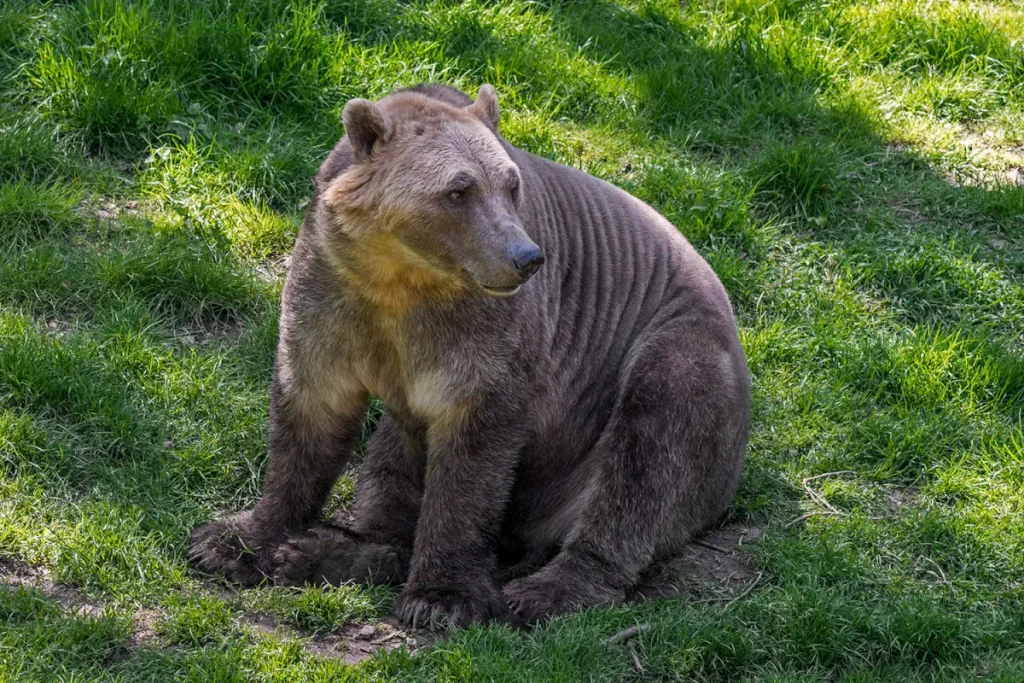
3. Their Fur Color Reflects a Unique Blend
Pizzly bears exhibit a distinctive fur coloration that falls between that of their parent species. Their coats are lighter than that of grizzly bears but darker than the pristine white fur of polar bears. This intermediate coloration not only highlights their hybrid nature but also serves as a form of camouflage in various habitats. The unique fur patterns can vary significantly among individuals, reflecting the genetic diversity inherent in hybridization.
4. Pizzly Bears Are Fertile Hybrids
Pizzly bears possess the unique ability to produce viable offspring, a characteristic attributed to the relatively recent divergence of their parent species. Grizzly bears and polar bears separated only about 500,000 to 600,000 years ago in evolutionary terms. This close genetic relationship allows them to mate successfully and give rise to hybrid bears, such as the pizzly.
Research indicates that hybridization can contribute to genetic diversity within bear populations, which may be crucial for their adaptation to changing environments. The fertility of pizzly bears is an essential aspect of their biology, enabling them to thrive in overlapping habitats where both parent species coexist.
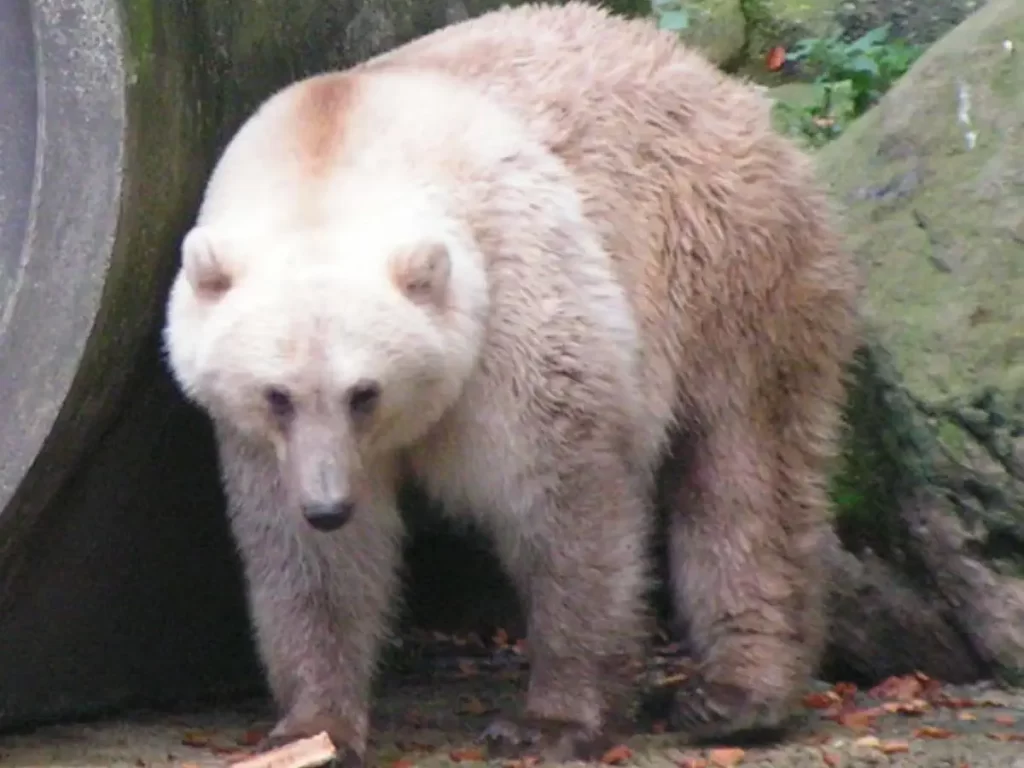
5. Pizzly Bears’ Behavior More Aligned with Polar Bears than Grizzlies
Research indicates that pizzly bears exhibit behaviors more akin to polar bears than grizzlies. This observation was notably documented in 2004 when two hybrid cubs, a male and a female were born at Osnabrück Zoo in Germany. Observers noted that these hybrids engaged in play behaviors reminiscent of polar bears, such as:
- They stomped toys in a manner reminiscent of how polar bears break the ice.
- They also hurled bags to the side “as polar bears may hurl prey”. When Grizzlies are given the same bags, they do not hurl them.
- The hybrids were also seen resting down on their bellies with their back legs outstretched, as polar bears do.
6. The First Pizzly Bear Sighted in the Wild in 2006
The first confirmed sighting of a pizzly bear occurred on April 16, 2006, when a hunter shot this double hybrid near Sachs Harbour on Banks Island, Northwest Territories, Canada. This incident was significant not only for the confirmation of the pizzly bear’s existence but also for raising questions about the instinctive reactions humans have toward unfamiliar animals. The hunter’s decision to kill the hybrid underscores the challenges of wildlife management in regions where encounters with different bear species are increasingly common.
Prior to this sighting, there had been anecdotal reports of potential wild-bred polar-grizzly hybrids, with some even being shot. However, the lack of DNA testing at the time made it impossible to confirm their ancestry. The 2006 incident marked a turning point in understanding these hybrids, highlighting the need for scientific research into the impact of climate change on bear populations and the dynamics of hybridization. This first documented pizzly bear emphasizes the importance of awareness and conservation efforts regarding hybrid species in a rapidly changing environment.
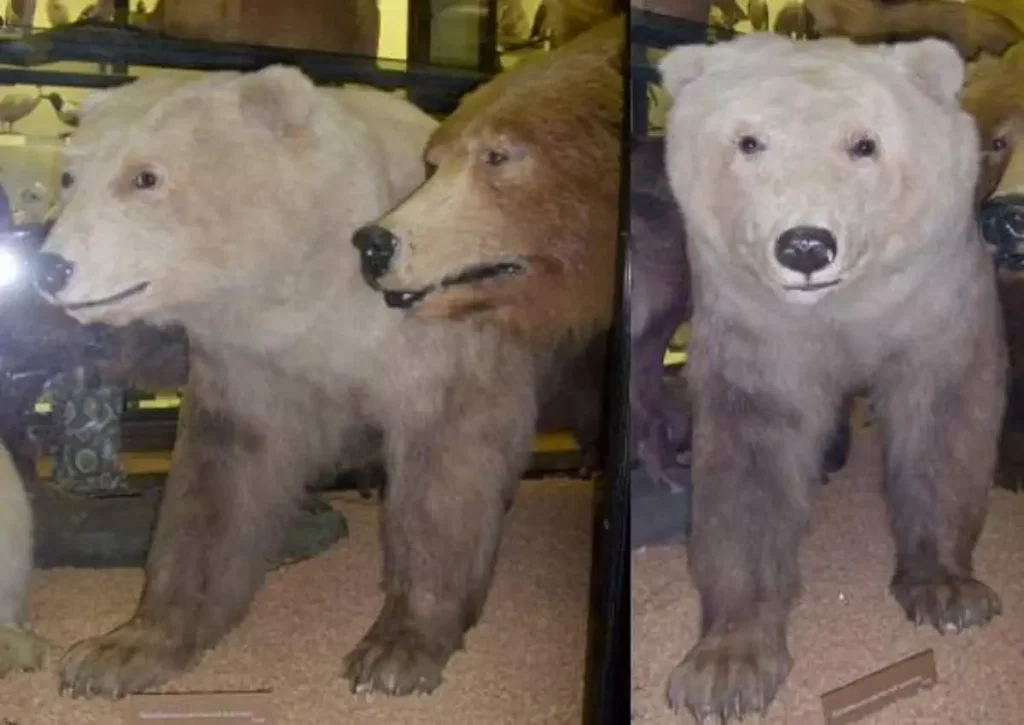
7. Pizzly Bears may be Better Able to Adapt to a Warming Arctic than Polar Bears
Scientists suggest that pizzly bears may be better equipped to adapt to a warming Arctic compared to polar bears. This adaptability is largely attributed to their hybrid nature, which combines the traits of both parent species. Unlike polar bears, which primarily depend on a diet of seals and other marine mammals, pizzly bears may have a broader range of food sources available to them. Grizzly bears, one of their parent species, have a more varied diet that includes everything from meat to vegetation, which could enhance the hybrid’s ability to thrive in changing environments.
While this hypothesis presents an intriguing possibility, researchers emphasize the need for further study and careful observation to fully understand the ecological implications of pizzly bears. As climate change continues to impact Arctic habitats, monitoring these hybrids could provide valuable insights into the adaptability of bear populations and their responses to environmental shifts.
8. Pizzly Bears are Better Swimmers than Grizzlies
Pizzly bears demonstrate better swimming capabilities than grizzly bears, which often struggle in aquatic environments. Their physical adaptations, inherited from their polar bear lineage, enable them to navigate water more effectively than their grizzly counterparts. While pizzly bears are proficient swimmers, they do not match the exceptional aquatic skills of polar bears, who are renowned for their ability to swim long distances in icy waters.
Polar bears have evolved to be highly specialized for life in the Arctic, relying on their swimming abilities to hunt seals and traverse vast ocean expanses. Pizzly bears, on the other hand, benefit from a combination of traits that allow them to thrive in both terrestrial and aquatic settings. Further research into the swimming behaviors of these hybrids could provide valuable insights into their adaptability and ecological role in changing habitats.

Related: 20 Amazing Polar Bear Facts
9. Not All Light-Colored Bears Are Pizzly Bears
Grizzly bears can exhibit a range of fur colors, including lighter shades. Notably, those inhabiting the Barren Grounds are often referred to as “blonde grizzlies” due to their lighter pelage. Consequently, sightings of light-colored bears -darker than polar bears- do not automatically indicate the presence of a pizzly bear.
For instance, in 2016, a bear shot near Arviat on the western shore of Hudson Bay was initially reported as a hybrid. However, subsequent genetic analysis revealed it to be a pure brown bear, underscoring the importance of genetic testing for accurate identification. This highlights the complexities of bear classification and the need for careful observation when encountering these magnificent creatures.
10. Pizzly Bear Numbers Are Increasing Due to Climate Change
As global warming continues to thin Arctic sea ice, polar bears are increasingly driven southward in search of alternative food sources. The traditional method of hunting seals from the sea ice has become increasingly untenable, leading to significant challenges for these apex predators. As they venture into new territories, they encounter grizzly bears, whose ranges are expanding northward due to rising temperatures.
This overlap between the two bear species has resulted in more frequent interactions and, subsequently, increased mating opportunities. As a consequence, the number of pizzly bears-hybrids of polar and grizzly bears-is on the rise. This hybridization reflects not only the adaptability of these species but also the significant ecological changes taking place in their habitats.
Scientists emphasize the importance of understanding these dynamics, as the growing pizzly bear population raises questions about the long-term implications for biodiversity and conservation efforts. Ongoing research is essential to monitor these changes and develop strategies to protect both species in a rapidly changing environment.
Bonus Pizzly Bear Fact: Double Hybrids (Grizzly-Polar Bear Crossbreeds) Have Been Observed
In addition to pizzly bears, the phenomenon of double hybrids, specifically, those resulting from the mating of hybrids with purebred bears has been observed. These double hybrids can occur when a pizzly bear mates with either a grizzly bear or a polar bear. Such occurrences highlight the fluidity of bear genetics and the adaptability of these species to changing environments. As climate change continues to alter habitats, the increased overlap between different bear populations fosters opportunities for hybridization, leading to more complex genetic combinations and potential new subspecies.
Research into these double hybrids is still emerging, but genetic analysis has confirmed their existence. In a notable study, a hybrid bear was found to have a grizzly-polar bear mother and a grizzly bear father, showcasing a unique mix of traits from all three species. This genetic flexibility not only raises intriguing questions about the evolution and adaptability of bears but also emphasizes the impact of environmental pressures on wildlife.
Pizzly Bear Occurrences in the Wild
Pizzly bears have been observed in the wild with several suspected sightings and eight confirmed cases. Theories about how these hybrids occur have gained traction as more evidence emerges. While polar bears primarily hunt, breed, and make maternity dens on sea ice, grizzly bears lead a predominantly terrestrial lifestyle. However, climate change and the increasing overlap of their habitats have led to more interactions between these sister species.
One theory posits that as the grizzly population grows, male bears leave their dens earlier while females remain with their cubs. This change may result in male grizzlies viewing female polar bears as viable mates, which could explain why hybrids are often reported with grizzly fathers and polar mothers. Additionally, as winters shorten and food sources dwindle in the Arctic, grizzlies have been observed hunting seals, traditionally polar bear prey. This close proximity during hunting could facilitate hybridization, prompting further research into these emerging dynamics.
2006 Discovery: The Ulukhaktok Bear, a Double Hybrid
A significant case occurred on April 16, 2006, when Jim Martell, a hunter from Idaho, shot a grizzly-polar bear hybrid near Sachs Harbour on Banks Island, Northwest Territories. Initially believing it to be a polar bear, Martell and his guide Roger Kuptana were surprised to discover that the animal possessed traits from both species, including thick, creamy white fur along with characteristics typical of grizzlies. If determined to be a grizzly, Martell would have faced significant penalties. DNA analysis by Wildlife Genetics International confirmed it was indeed a hybrid, marking the first documented case in the wild.
The discovery gained widespread attention, particularly when The Colbert Report humorously named the hybrid as a top threat to American security shortly after the news broke. Following much controversy, the bear was ultimately returned to Martell.
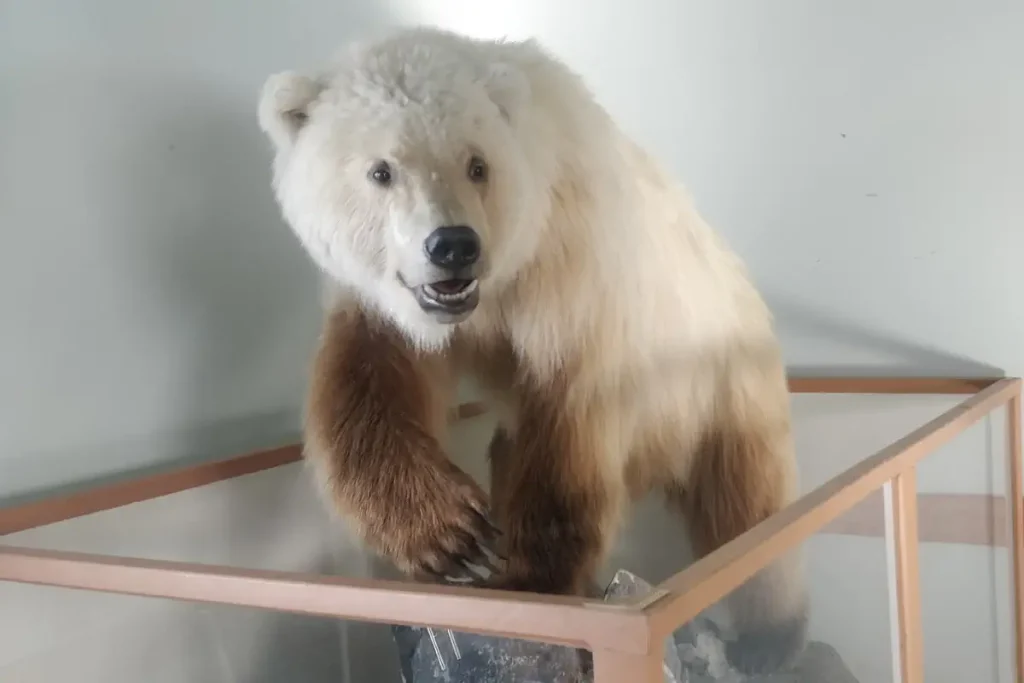
Subsequent Discoveries
In a subsequent case on April 8, 2010, David Kuptana, another Inuvialuit hunter from the community of Ulukhaktok on Victoria Island, shot what he initially thought was a polar bear. Genetic testing revealed that the bear’s mother was a grizzly-polar hybrid, while its father was a grizzly bear. The physical characteristics of this bear showcased traits intermediate between the two species, further highlighting the complexities of hybridization.
Between 2012 and 2014, six more hybrid bears were documented, either killed by hunters or captured by biologists. Genetic analysis confirmed their hybrid status and familial relationships. The eight hybrids identified so far include four first-generation (F1) hybrids and four backcross individuals, illustrating the intricacies of grizzly and polar bear genetics.
Sources
- Grizzly-polar bear hybrid (the Pizzly Bear) on Wikipedia
- Should You Fear the Pizzly Bear? on the New York Times website
- “Pizzly bear hybrids are spreading across the Arctic thanks to climate change” on Live Science
- “Vanderbilt researcher explains Pizzly bear hybrid species” on the Vanderbilt University website
- “Warming Arctic Creating Pizzly Bear Hybrids” on the Living on Earth website
- How Many Elephants are Left in the World in 2025? - August 17, 2025
- Moon Landings: All-Time List [1966-2025] - February 2, 2025
- What Is Max-Q and Why Is It Important During Rocket Launches? - January 16, 2025

3 replies on “Pizzly Bear: 10 Fascinating Facts About Polar-Grizzly Hybrids”
why are pizzlys so undiscoverd unlike polar bears and grizzlies?
Probably because they are so rare. We weren’t even sure if they are real or not until recently.
Wilirdia should never be used for a research paper, it is not peer reviewed.